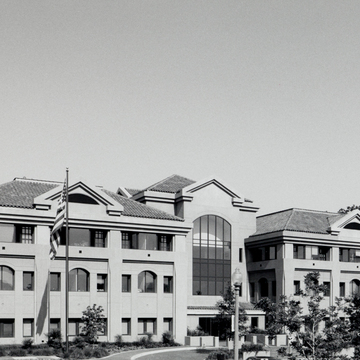The State Department's administrative center for the adjacent chanceries as well as for those located elsewhere in the city was conceived by its architect as a town hall with architectural antecedents that were generically early twentieth-century American. The composition of its facade is highly formal—two symmetrical wings arranged around a recessed entry. The whole building is a three-story cubic block; all facades are treated alike, with low, wide central pediments and the red barrel clay tile roof giving it a decidedly Mediterranean look. The architectural language is an abstract version of classicism, with the Renaissance tradition contributing its major features. The building material is cast stone treated to resemble stuccoed walls with most horizontal joins masked to give the appearance of continuous surfaces. Scoring of the walls in discrete areas into rectilinear panels is unrelated to structure but an effective proportioning device that visually breaks down the building's large mass. The middle story is articulated with triple windows reminiscent of the Palladian motif, and top-floor windows form a continuous band of green solar-glass window wall, faceted to form recessed octagonal bays that hark back to window shapes of Victorian row houses. Green aluminum for the narrow window frames makes an elegant transition between sand-colored walls and green glass.
You are here
Federal Office Building, Department of State
If SAH Archipedia has been useful to you, please consider supporting it.
SAH Archipedia tells the story of the United States through its buildings, landscapes, and cities. This freely available resource empowers the public with authoritative knowledge that deepens their understanding and appreciation of the built environment. But the Society of Architectural Historians, which created SAH Archipedia with University of Virginia Press, needs your support to maintain the high-caliber research, writing, photography, cartography, editing, design, and programming that make SAH Archipedia a trusted online resource available to all who value the history of place, heritage tourism, and learning.

